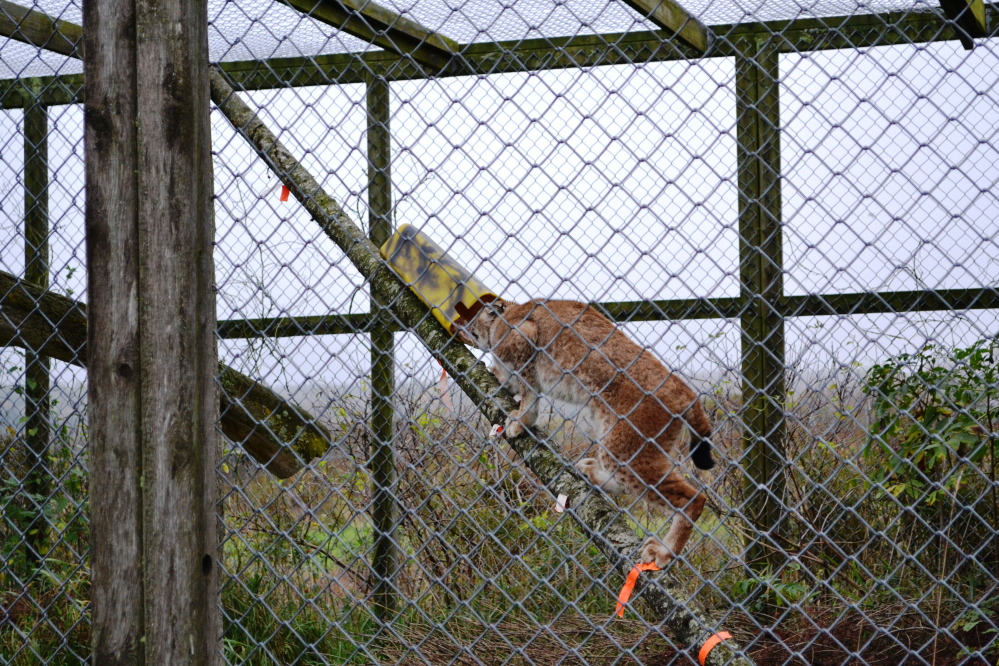RICHMOND, Vt. — They’re called “leaning poles”: narrow, steeply inclined shafts propped on trees to act as ramps for pine martens, fishers and other target animals to access baited steel traps.
Officials at the Maine Department of Inland Fisheries and Wildlife theorized that if the poles were no more than 4 inches in diameter and propped at an incline of at least 45 degrees, threatened lynx would not be able to reach the deadly traps.
But long before officials at the U.S. Fish and Wildlife Service granted the state a permit in early November to proceed with its trapping program in known lynx habitat, they already knew the theory was dead wrong: Three years earlier, the federal agency had tested the leaning-pole setup with captive lynx and found the animals had no problem accessing deadly traps.
Yet the Fish and Wildlife Service still issued the Endangered Species Act-required incidental-take permit to Maine, even mentioning the importance of the leaning-pole setup in the permit.
Just two weeks after the permit was issued, the very predictable cost of federal officials’ negligent decision was made clear when a protected lynx was killed by a trap atop a leaning pole set in accord with the state’s flawed specifications.
The news Dec. 7 of the second death of a lynx – along with confirmed reports that already 19 lynx have been captured this trapping season (including several since the permit was approved) – raises important questions about why the Fish and Wildlife Service knowingly put a threatened species at such severe additional risk.
THE THREAT IS REAL
What’s not in question is the long decline of the nation’s populations of the 15- to 30-pound wildcat, characterized by its huge paws, long black ear tufts and almost complete dependence on snowshoe hare as a food source.
In the Lower 48 states, the lynx is now found only in a few areas, including Washington state, the northern Rockies, Minnesota and the Northeast, where its only breeding population of several hundred lives in northern Maine. Because of that decline, the lynx was listed as a threatened species under the federal Endangered Species Act in 2000.
The second lynx mortality, which comes in the first month of the 15-year permit, triggered a clause in the permit that forced the state to take immediate action to reduce the risk of another death. The state responded by prohibiting the use of body-crushing conibear traps as well as foothold traps in elevated setups, within zones occupied by lynx. The conibear traps may still be used if set on the ground with “lynx exclusion devices,” and foothold traps may still be used if set on the ground.
The permit allows up to 195 lynx to be captured and three killed over 15 years in traps set for marten, fisher, coyotes and other species. To offset trapping impacts on lynx, Maine agreed to manage (i.e., log) roughly 6,000 acres of state forest north of Moosehead Lake for snowshoe hare and lynx habitat.
DEER ALSO AFFECTED
But this mitigation measure demonstrates yet another flaw of the trapping plan. The mitigation area hosts prime deer wintering habitat: older forests that are now rare in Maine because of widespread industrial forestry.
Not only will white-tailed deer lose important habitat so that the state wildlife agency can mitigate its trapping program, but the effectiveness of that mitigation is in serious doubt because trapping will still be allowed in the lynx mitigation area.
It’s undeniable at this point that the Fish and Wildlife Service approved a deeply flawed permit. And serious unanswered questions remain regarding how well lynx will fare under the current emergency provisions of the trapping permit, and whether the Fish and Wildlife Service has now learned its lesson.
Going forward, will the federal agency make permit decisions based on science and the needs of the threatened lynx, or will it again allow trapping policies known to be ineffective at protecting them? Let’s hope it doesn’t take more dead lynx for this lesson to stick.
— Special to the Press Herald
Send questions/comments to the editors.



Success. Please wait for the page to reload. If the page does not reload within 5 seconds, please refresh the page.
Enter your email and password to access comments.
Hi, to comment on stories you must . This profile is in addition to your subscription and website login.
Already have a commenting profile? .
Invalid username/password.
Please check your email to confirm and complete your registration.
Only subscribers are eligible to post comments. Please subscribe or login first for digital access. Here’s why.
Use the form below to reset your password. When you've submitted your account email, we will send an email with a reset code.